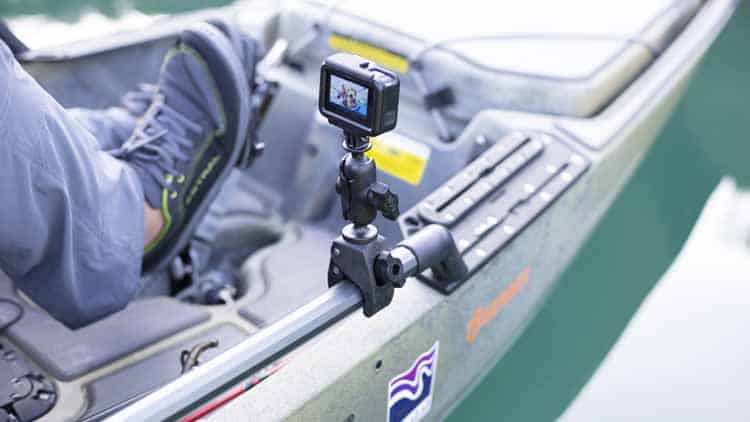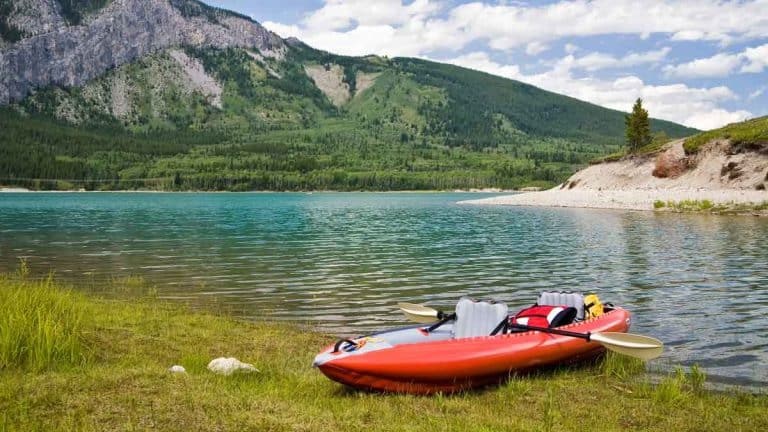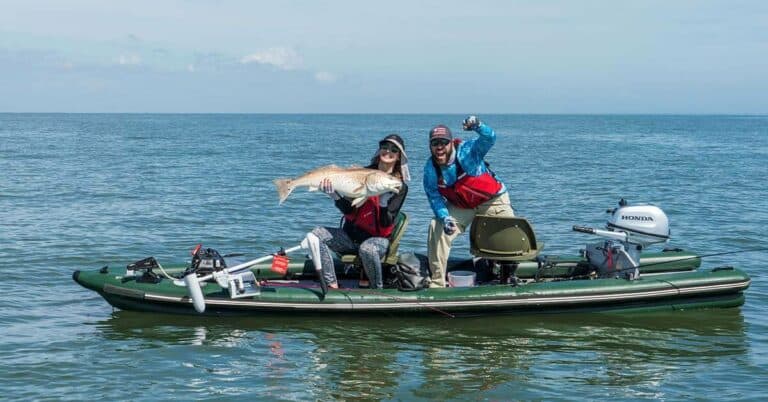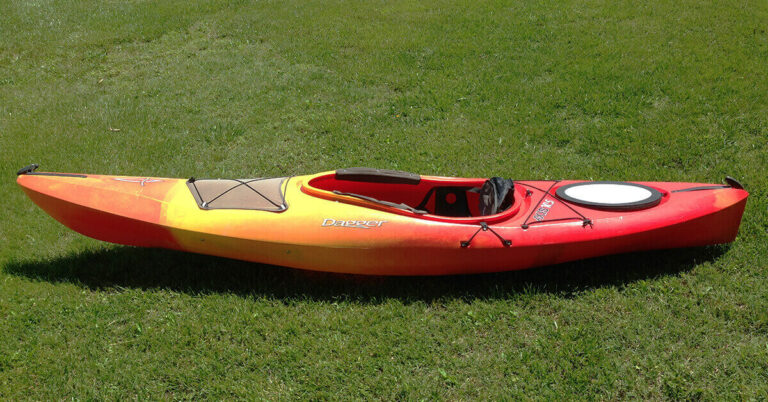Disclosure: I am compensated for purchases made through some links on this site. Click for details.
Pedal kayaks have a pedal drive system reminiscent to that of a recumbent bike. The unique design allows hands-free kayaking with minimal effort. Pedal kayaks bring with them a series of questions that must be understood to determine if one of these boats is the best fit for your style of boating.
What Are the Different Types of Pedal Kayaks?
Pedal kayaks are most often marketed as pedal fishing kayaks and recreational pedal kayaks, though they are also used for hunting and wildlife photography. There are also two different types of pedal drive kayaks based on the drive type used for propulsion: push pedal and rotational pedal.
So… What are the kayaks with pedals called? Push pedal kayaks and rotational pedal kayaks.
Push Pedal Kayaks
Push pedal kayaks are propelled by pedals attached to fins on the underside of the kayak. Forward propulsion is achieved by interchangeably pushing each pedal forward and because your feet are tucked under pedal straps you pull the pedal back into position for the next forward thrust.
To pedal in reverse, many push pedal kayaks have a manual adjust shift mechanism for reverse pedaling.
Rotational Pedal Kayaks
Rotational pedal kayaks are similar to recumbent bikes where the rider is in a seated position behind the pedals. Pushing the rotational pedals with your feet transfers power to a propeller under the kayak. Pedaling forward provides forward momentum. Pedaling backward provides reverse momentum.
What Should I Look for in a Pedal Kayak?
Kayak Size – A pedal kayak’s size in both length and width can vary depending on its intended use. Size affects the kayak’s weight, handling capabilities, cargo space, and how easy it is to transport and store.
Hardshell or Inflatable – There are inflatable pedal kayaks like the BOTE LONO Areo or Hobie iTrek that will save on weight and make storage and transportation of the kayak a breeze. If you are limited on space at home for storage or need to be able to haul your kayak in the trunk of your car, inflatable kayaks are an excellent option.
Weight Capacity – How much weight will you carry in your pedal kayak? Different kayaks have different weight capacities. This includes the weight of passengers and gear. If your kayak is overloaded it will be unstable, sit too low in the water, and reduce the kayak’s performance, and your efficiency in pedaling and paddling.
Passengers – Solo pedal kayaks are the most common but tandem pedal kayaks are available. The biggest I know of is the Hobie Mirage iTrek Fiesta, a four-person inflatable paddle kayak that is more like an oversized paddleboard with chairs and pedals. It looks like a really fun boat for family and friends.
Pedal Drive Type – There are two types of pedal drive kayaks available. Push pedal kayaks propelled by pedals attached to fins on the underside of the kayak and rotational pedal kayaks with a propeller drive.
Controls – A rudder, rudder controls, and the ability to pedal forward or reverse can improve your ability to turn, position, and maneuver the kayak to your liking.
Accessories – Your intended use will determine which accessories are important to you. You may only want a cup holder or a fishing rod holder but you can get so much more.
Storage – Internal storage on a kayak can vary greatly from a small storage hatch or a well for gear, tools, ice, or fish to in-hull storage where you can put extra rods. Many pedal kayaks also have space on the deck for an ice cooler and tackle boxes.
Comfort – Comfort on a kayak encompasses stability, seating, standing, legroom, and proximity.
- Stability is a huge comfort factor when pedaling, paddling, casting, and especially when standing to fish.
- Ergonomic seats with padding and back support are available. Trimmable seats that can move both forward and aft for leg comfort while paddling is also desirable.
- Is there deck space to stand and fish? Many pedal drive systems limit deck space.
- If you are taller legroom can be very important.
- Your ability to easily reach your desired gear and controls is important, especially in a pedal fishing kayak.
Kayak Hull – The width, length, and hull shape of a kayak affect stability, maneuverability, acceleration, speed, responsiveness, and tracking in varying water conditions.
On what type of water and in what conditions will you use your pedal kayak? Waves, currents, tides, wind, water depth, and more can be determining factors.
In general, wider hulls are more stable, while narrower hulls can go faster and longer kayaks track and cruise with greater efficiency, while shorter kayaks are more agile and turn quicker.
As far as hull shape goes, v-shaped, rounded, flat, and pontoon hulls have performance advantages in different types of water. For instance, a flat-bottom kayak will improve balance on a lake or pond but it lacks the necessary tracking capabilities to handle river or ocean currents due to its minimal water resistance.
Deck Space – Pedal drive kayaks often have limited deck space. This can be a critical factor for many anglers who like to stand and fish. If deck space is a critical factor, look for a kayak with more deck space or a pedal drive system that will flip up out of your way when not in use.
Hull Materials – Kayaks are most often made from polyethylene plastic, ABS plastic, or composite material. Each of these materials has its own advantage in weight, abrasion resistance, UV resistance, recyclability, and price.
Visual Aspect – Do you like the look of the kayak and can you get the color you want?
Easy Maintenance – The pedal drive should be easy to install, remove, and clean. The ability to access the drive while on the water is also a nice option. It’s not uncommon to get vegetation or a fishing line caught up in the pedal drive system. Paddling to shore to fix a problem is not always a good option.
For example, the Jackson Kayak Flex Drive 3D Pedal Drive makes maintenance easy. It has a driveshaft that automatically flexes and flips up to be protected by the hull from shallow water, grassy areas, and submerged obstacles and a hinged prop cover that raises so you can have access to the propeller for cleaning and repair.
Transportability – Can you transport the pedal kayak on a roof rack, in a truck bed, or will you need a trailer? Maybe you want an inflatable pedal kayak that will store easily in the trunk of your car.
Portability – Will you be able to carry the pedal kayak from your vehicle to the water or will you need the assistance of another person or a kayak cart?
Brand – Major kayak brands like Jackson Kayak, Hobie, Old Town, Ocean Kayak, Pelican, and Wilderness Systems offer a history of reliable products, services, and warranties that can offer great peace of mind. After all, the cost of a good pedal kayak is going to set you back quite a bit.
Cost – Pedal kayaks range in price from the $1000 Pelican Premium Getaway 110 HDII Pedal Kayak to $4200 for the Jackson Kayak Knarr FD.
Are There 2-Person Pedal Kayaks?
Yes, two-person pedal kayaks for recreational use and kayak fishing are available and they are growing in popularity. Hobie has the largest selection of tandem pedal kayaks all of which have push pedal drive. Brooklyn Kayak Company and Feelfree Kayaks have tandem pedal kayaks with rotational pedals.
Below is a list of available tandem pedal kayaks, the pedal drive type, and the number of pedal drives per kayak.
| Kayak Brand | Tandem Pedal Kayak Model | Pedal Drive Type | # of Pedal Drives |
|---|---|---|---|
| Brooklyn Kayak Co. | BKC PK14 Angler Tandem Pedal Kayak | Rotational Pedal Drive | 2 |
| Feelfree Kayaks | Lure II Tandem Overdrive | Rotational Pedal Drive | 1 |
| Hobie | Mirage Oasis | Push Pedal Drive | 2 |
| Hobie | Mirage Compass Duo | Push Pedal Drive | 2 |
| Hobie | Mirage iTrek 14 Duo | Push Pedal Drive | 2 |
| Hobie | Mirage Tandem Island | Push Pedal Drive | 2 |
What Is the Lightest Pedal Kayak?
The lightest pedal kayak is the Hobie Mirage iTrek 9 Ultralight, though it isn’t a traditional kayak. It’s really a paddleboard. The lightest pedal fishing kayak is the Native Watercraft Slyer Propel 10. Here are the four lightest pedal kayaks based on kayak type and structure.
| Kayak Brand | Pedal Kayak Model | Kayak Style | Structure | Pedal Version | Fully Rigged Weight* |
|---|---|---|---|---|---|
| Hobie | Mirage iTrek 9 Ultralight | Recreational Paddleboard | Inflatable | Push Pedal | 36 lbs |
| Pelican | Premium Getaway 110 HDII | Recreational | Hard Shell | Push Pedal | 65 lbs |
| Native Watercraft | Slyer Propel 10 | Fishing | Hard Shell | Rotational Pedal | 81 lbs |
| Bote | LONO Aero 12′6″ | Recreational | Inflatable | Rotational Pedal | 93 lbs |
Do I Need a Pedal Kayak for Fishing?
No, absolutely not. You do not need a pedal kayak for fishing.
There are, however, some pros and cons to having a pedal fishing kayak. Let’s take a look.
Pedal Drive Fishing Kayaks Pros and Cons
Pros
- You can get farther faster when on open water. This allows you to get to as many fishing spots as possible in a limited time.
- Often wider and more stable than paddle kayaks.
- Offer greater power over paddle kayaks.
- Your hands are free for fishing.
- Easier for troll fishing.
- Easily cover areas larger fishing boats can’t reach.
- Put in from just about anywhere.
- You can maintain your position by peddling instead of using a paddle.
Cons
- Can get hung up on vegetation in shallow waters.
- Heavier and harder to lift than paddle kayaks.
- They are twice as expensive as paddle fishing kayaks.
- Pedal drive systems take up deck space and legroom.
- Greater maintenance than paddle kayaks.
- Have to disengage and lift the pedal drive system in shallow water unless you have a Jackson Kayak Flex Drive where the driveshaft automatically flexes and flips up to be protected by the hull.
- Less stealthy. Kayak pedal drive systems make more noise than paddling.
Is a Pedal Kayak Worth It for Fishing?
Yes, pedal drive kayaks are worth the extra cost if you have the cash and it fits into your type of fishing. The ease of hands-free fishing, greater stability, and efficiency in reaching your fishing spot faster makes fishing in a pedal kayak easier and provides more fishing time while on the water.
There is a big price difference between pedal and paddle kayaks. Let’s look at some of the available models from Jackson Kayak that come in both pedal and paddle and the pricing at the time of this article.
I chose Jackson Kayak only because they offer the exact kayaks with and without pedal drives. This gives a more accurate price comparison.
| Kayak Brand | Pedal Kayak Model | Pedal Kayak Price | Paddle Kayak Model | Paddle Kayak Price |
|---|---|---|---|---|
| Jackson Kayak | Bite FD | $2,999 | Bite Angler | $1,099 |
| Jackson Kayak | Coosa FD | $3,759 | Coosa HD | $1,949 |
Other companies like Wilderness Systems and Bote sell their pedal drive systems separately. These systems would be compatible with select boats from the respective brand.
| Kayak Brand | Pedal Drive System | Price |
|---|---|---|
| Bote | APEX Pedal Drive | $899 |
| Vibe Kayaks | X-Drive | $599 |
| Wilderness Systems | Helix PD Pedal Drive | $1,350 |
Can You Use a Paddle with a Pedal Kayak?
Yes, not only can you use a paddle with a pedal kayak you should always carry a paddle with you on your pedal kayak to use in certain situations pedal drive malfunction, areas of heavy vegetation, maneuvering in shallow water, stealthily sneaking into your fishing spot, and for stand up paddling.
Reasons Why You Still Use a Paddle with a Pedal Kayak:
Safety – If your pedal drive gives you problems, you can always paddle back to the put-in.
Vegetation – A paddle won’t get caught up in vegetation like a paddle drive. If you find yourself fishing in heavy vegetation, you can pull up the pedal drive and paddle.
Shallow Water – A paddle can take a kayak into shallower water than a pedal drive system.
Quiet Paddling – Paddles are quieter and great for easing into position without scaring the fish away.
Stand-Up Paddling – If you stand and fish, you can continue to stand and maneuver your kayak around with a paddle instead of sitting back down at the pedal drive to change positions.
For an expanded answer on paddling a pedal kayak, check out: Why You Still Use a Paddle with a Pedal Kayak: But Simultaneously?
Can You Paddle and Pedal a Kayak at the Same Time?
Yes, you can paddle and pedal at the same time. They are not mutually exclusive, though pedaling and paddle strokes are different. It can be a bit like rubbing your tummy and patting your head. There’s also a question of whether there is any reasonable gain when peddling and paddling simultaneously.
Disadvantages of Paddling and Pedaling a Kayak at the Same Time:
Drag – The drag of the pedal system in the water can work against the power stroke of your paddle.
Poor Timing – You can hit your knees with the paddle if your timing is off. The key is coordinating the extension or power stroke of your leg with the power stroke of your paddle. The kayaker’s height, seat position, and the design of the kayak also have a bearing in whether you hit your knees while paddling.
Extra Effort – Pedaling and paddling at the same time can be quite a workout.
Impaired Tracking – Paddle stroke movements can impair tracking on some pedal drive kayaks that are optimized around their pedal drive systems. To compensate, lock your rudder to go straight like a skeg while paddling. You’ll need a workaround if your kayak doesn’t have a steering lockdown feature.
Are Pedal Kayaks Faster than Paddle Kayaks?
Yes, both push pedal kayaks that are propelled by pedals attached to fins and rotational pedal kayaks that transfer power to a propeller can generate greater forward thrust than that of a standard paddle. They are also designed to drive you forward through the water with lower physical exertion.
Your speed in a pedal kayak depends on your physical condition, leg strength, the kayak’s design, and the pedal drive. Because a person’s legs are usually stronger than their arms, speeds of over 5 mph can be achieved and maintained for longer periods of time allowing you to cover more water faster.
Can Pedal Kayaks Go in Shallow Water?
Mud, vegetation, rocks, and other obstacles can restrict pedal-drive kayaks in shallow water. Some high-quality kayak manufacturers have pedal drives that retract into the hull upon impact or push pedal systems that keep the fins flat against the hull by pushing one pedal forward and the other back.
Two of the top companies with these retractable drives are Hobie with the push pedal MirageDrive 180 and MirageDrive 360 and Jackson Kayak with the rotational pedal Flex Drive.
To avoid damage to your kayak’s pedal drive system in shallow water, or when launching or beaching, it is best to lift up or remove your pedal drive and paddle.
If you have a pedal drive like the Hobie MirageDrive with fins that pull up flat against the hull, you can propel the kayak with short pedal strokes while keeping the fins in an upward position essentially flutter-kicking the fins. This allows you to pedal through water less than a foot deep.
Can You Install Pedals on Any Kayak?
Yes, you can turn a regular kayak into a pedal kayak with aftermarket pedal drive systems like the innovative H2Pro-Ped pedal drive propulsion system. The lightweight H2Pro-Ped will install on most kayaks in minutes without destructive modifications to the kayak like drilling or custom fastening.
Can You Use a Pedal Kayak in the Ocean?
Yes, as long as you have a pedal kayak with a hull designed for handling ocean swells, waves, and currents. Ocean pedal kayaks have a longer sleeker hull for improved tracking and powering through waves. They also have below-deck storage for protecting gear during surf launch and on rough water.
Here is a list of the best ocean pedal kayaks:
- Old Town Sportsman Salty PDL 120
- Vibe Sea Ghost 130 w/ X-Drive Pedal Kit
- Hobie Mirage Revolution 13
- Hobie Mirage Oasis (tandem)
- Hobie Mirage Pro Angler 14 w/ 360 Drive
- Hobie Mirage Pro Angler 14
- Hobie Mirage Tandem Island
- Jackson Kayak Knarr FD
- FeelFree Lure 13.5 V2 w/ Overdrive Pedal System
How Do You Steer a Pedal Kayak?
The most common way to steer a pedal kayak is by using a rudder. If you don’t have a rudder, the kayak can be steered with the blade of a paddle, leaning your torso to the side you wish to turn, or you may have a pedal drive system that turns to create force in the direction you wish to turn.
Can You Go Backward in a Pedal Kayak?
Yes. With a rotational pedal kayak, just pedal backward. Push pedal kayaks aren’t as simple. Some don’t have a reverse. Some have to be pulled out and installed in reverse. Hobie uses a pull cable to reverse fin direction with the MirageDrive 180 and the MirageDrive 360 system rotates into reverse.
Is a Pedal Kayak Good Exercise?
Yes, pedal kayaking is a great aerobic exercise that provides cardiovascular conditioning as cycling does. The wind and water conditions in combination with pedaling speed can provide a strenuous workout. If you want to increase the cardio load, add paddling for both an upper and lower-body workout.
Can You Put a Trolling Motor on a Pedal Kayak?
Yes. Trolling motors can be mounted on pedal kayaks. All you need is a compatible motor mount and a trolling motor with a thrust and weight that is within the capacity of the motor mount and kayak. Trolling motor mounts are made by manufacturers for specific kayak models and aftermarket options.
Some kayak manufacturers like Jackson Kayak have a motorized pod that can be popped in where the pedal system is installed.
What Is the Cost of a Pedal Kayak?
Pedal kayaks range in price from the $1000 Pelican Premium Getaway 110 HDII Pedal Kayak to $4200 for the Jackson Kayak Knarr FD. Like anything else in life, you get what you pay for. This Pelican kayak is a simple recreational kayak whereas the Jackson Kayak is a fishing kayak loaded with amenities.
Why Are Pedal Kayaks So Expensive?
Pedal kayaks are so expensive because of the advanced design features of these kayaks over basic kayaks. The cost of pedal kayaks reflects the kayak’s quality, material costs, retractable or kick-up pedal technology, the specific purpose such as pedal kayak fishing, and the manufacturing location.






